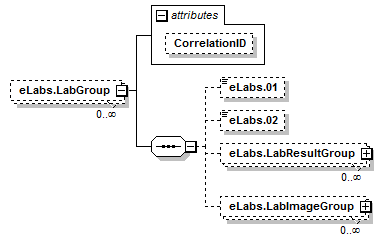
Namespace: |
|
Type: |
anonymous complexType |
Content: |
|
Defined: |
|
Includes: |

| XML Representation Summary | |||||
| <eLabs.LabGroup | |||||
| CorrelationID | = |
xs:string | |||
| > | |||||
|
|||||
| </eLabs.LabGroup> | |||||
| <xs:element id="eLabs.LabGroup" maxOccurs="unbounded" minOccurs="0" name="eLabs.LabGroup"> <xs:complexType> <xs:sequence> <xs:element id="eLabs.DateTimeLaboratoryorImagingResult" minOccurs="0" name="eLabs.01" type="DateTimeType"/> <xs:element id="eLabs.StudyResultPriortothisUnitsEMSCare" minOccurs="0" name="eLabs.02" type="YesNoValues"/> <xs:element id="eLabs.LabResultGroup" maxOccurs="unbounded" minOccurs="0" name="eLabs.LabResultGroup"> <xs:complexType> <xs:sequence> <xs:element id="eLabs.LaboratoryResultType" minOccurs="0" name="eLabs.03" type="LaboratoryResultType"/> </xs:sequence> </xs:complexType> </xs:element> <xs:element id="eLabs.LabImageGroup" maxOccurs="unbounded" minOccurs="0" name="eLabs.LabImageGroup"> <xs:complexType> <xs:sequence> <xs:element id="eLabs.ImagingStudyResults" minOccurs="0" name="eLabs.06" type="ImagingStudyResults"/> <xs:element id="eLabs.WaveformGraphicGroup" maxOccurs="unbounded" minOccurs="0" name="eLabs.WaveformGraphicGroup"> <xs:complexType> <xs:sequence> </xs:sequence> </xs:complexType> </xs:element> </xs:sequence> </xs:complexType> </xs:element> </xs:sequence> </xs:complexType> </xs:element> |
Type: |
|
Use: |
optional |
| xs:string |
MaxLength: |
255 |
MinLength: |
0 |
| <xs:attribute name="CorrelationID" type="CorrelationID" use="optional"/> |
Type: |
DateTimeType, simple content |
| xs:dateTime |
maxInclusive: |
2050-01-01T00:00:00-00:00 |
minInclusive: |
1950-01-01T00:00:00-00:00 |
Pattern: |
[0-9]{4}-[0-9]{2}-[0-9]{2}T[0-9]{2}:[0-9]{2}:[0-9]{2}(\.\d+)?(\+|-)[0-9]{2}:[0-9]{2} |
| <xs:element id="eLabs.DateTimeLaboratoryorImagingResult" minOccurs="0" name="eLabs.01" type="DateTimeType"/> |
Type: |
YesNoValues, simple content |
| enumeration of xs:string |
Enumeration: |
|
| <xs:element id="eLabs.StudyResultPriortothisUnitsEMSCare" minOccurs="0" name="eLabs.02" type="YesNoValues"/> |
Type: |
anonymous, complex content |
| <xs:element id="eLabs.LabImageGroup" maxOccurs="unbounded" minOccurs="0" name="eLabs.LabImageGroup"> <xs:complexType> <xs:sequence> <xs:element id="eLabs.ImagingStudyResults" minOccurs="0" name="eLabs.06" type="ImagingStudyResults"/> <xs:element id="eLabs.WaveformGraphicGroup" maxOccurs="unbounded" minOccurs="0" name="eLabs.WaveformGraphicGroup"> <xs:complexType> <xs:sequence> </xs:sequence> </xs:complexType> </xs:element> </xs:sequence> </xs:complexType> </xs:element> |
Type: |
anonymous, complex content |
| <xs:element id="eLabs.LabResultGroup" maxOccurs="unbounded" minOccurs="0" name="eLabs.LabResultGroup"> <xs:complexType> <xs:sequence> <xs:element id="eLabs.LaboratoryResultType" minOccurs="0" name="eLabs.03" type="LaboratoryResultType"/> </xs:sequence> </xs:complexType> </xs:element> |